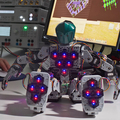Intelligent machines develop self-awareness:
Scientists develop sensitive skin for robots

The Bioloid Robot with 31 hexagonal sensor modules distributed throughout its body. Similar to human skin, the sensor modules measure, temperature, touch and speed. (Photo: Heddergott / TUM)
29.06.2011, Press releases
Robots will soon be able to feel heat or gentle touching on their surfaces. Researchers of the Excellence Cluster CoTeSys at the Technical University Munich (Technische Universität München, TUM) are now producing small hexagonal plates which when joined together form a sensitive skin for “machines with brains.” This will not only help robots to better navigate in their environments, it will also enable robot self-perception for the first time. A single robotic arm has already been partially equipped with sensors and proves that the concept works.
Our skin is a communicative wonder: The nerves convey temperature, pressure, shear forces and vibrations – from the finest breath of air to touch to pain. At the same time, the skin is the organ by which we set ourselves apart from our environment and distinguish between environment and body. Scientists at TUM are now developing an artificial skin for robots with a similar purpose: It will provide important tactile information to the robot and thus supplement its perception formed by camera eyes, infrared scanners and gripping hands. As with human skin, the way the artificial skin is touched could, for example, lead to a spontaneous retreat (when the robot hits an object) or cause the machine to use its eyes for the first time to search for the source of contact.
Such behavior is especially important for robotic helpers of people traveling in constantly changing environments. According to robot vision, this is just a regular apartment in which things often change position and people and pets move around. “In contrast to the tactile information provided by the skin, the sense of sight is limited because objects can be hidden,” explains Philip Mittendorfer, a scientist who develops the artificial skin at the Institute of Cognitive Systems at TUM.
Infrared sensors simulate touch
The centerpiece of the new robotic shell is a 5 square centimeter hexagonal plate or circuit board. Each small circuit board contains four infrared sensors that detect anything closer than 1 centimeter. “We thus simulate light touch,” explains Mittendorfer. “This corresponds to our sense of the fine hairs on our skin being gently stroked.” There are also six temperature sensors and an accelerometer. This allows the machine to accurately register the movement of individual limbs, for example, of its arms, and thus to learn what body parts it has just moved. “We try to pack many different sensory modalities into the smallest of spaces,” explains the engineer. “In addition, it is easy to expand the circuit boards to later include other sensors, for example, pressure.”
Plate for plate, the boards are placed together forming a honeycomb-like, planar structure to be worn by the robot. For the machine to have detection ability, the signals from the sensors must be processed by a central computer. This enables each sensory module to not only pass its own information, but to also serve as a data hub for different sensory elements. This happens automatically, ensuring that signals can go in alternative ways if a connection should fail.
Ability to form a self-impression
Only a small piece of skin is currently complete. These 15 sensors, however, at least one on each segment of a long robot arm, already show that the principle works. Just a light pat or blow ensures that the arm reacts. “We will close the skin and generate a prototype which is completely enclosed with these sensors and can interact anew with its environment,” claims Mittendorfer’s supervisor, Prof. Gordon Cheng. Prof. Cheng expounds that this will be “a machine that notices when you tap it on the back… even in the dark.”
The pioneering aspects of the concept do not end with its sensory accomplishments. Beyond this, these machines will someday be able to incorporate our fundamental neurobiological capabilities and form a self-impression. The robot has moved a step closer to humanity.
Publication:
IEEE Transactions on Robotics, Special Issue on Robotic Sense of Touch, Volume 27 Issue 2
http://ieeexplore.ieee.org/xpls/abs_all.jsp?arnumber=5711674&tag=1
Photos (from Andreas Heddergott / Technische Universitaet Muenchen):
http://www.cotesys.de/media/pictures-for-press.html
Video:
http://www.youtube.com/watch?v=5CILOcxjkQY
Contact:
Philipp Mittendorfer, Prof. Gordon Cheng
Institute for Cognitive Systems (Chair Prof. Gordon Cheng)
Technische Universitaet Muenchen
phone: +49 (0)89 289 25723 (Wibke Borngesser)
e-mail: philipp.mittendorfer@tum.de
Kontakt: presse@tum.de
More Information
| 110629_Roboterhaut_DE.pdf |
Druckfassung der Presseinformation "Roboterhaut" (deutsch),
(Type: application/x-download,
Size: 115.6 kB)
Save attachment
|
|
| 110629_robotskin.pdf |
Printable version of press release "robot skin" (english),
(Type: application/x-download,
Size: 114.5 kB)
Save attachment
|



